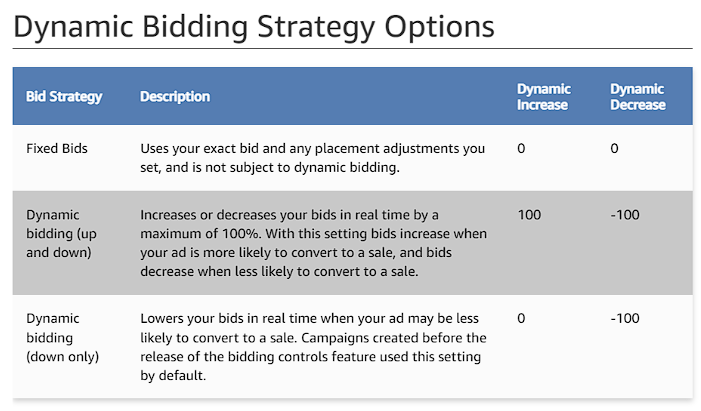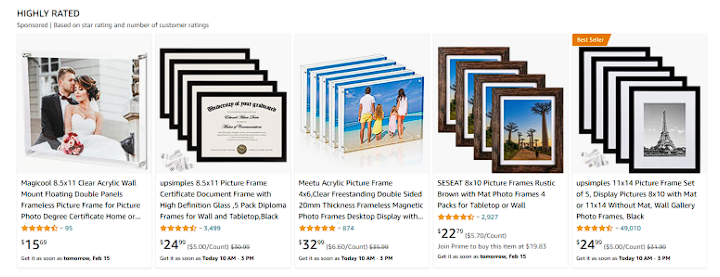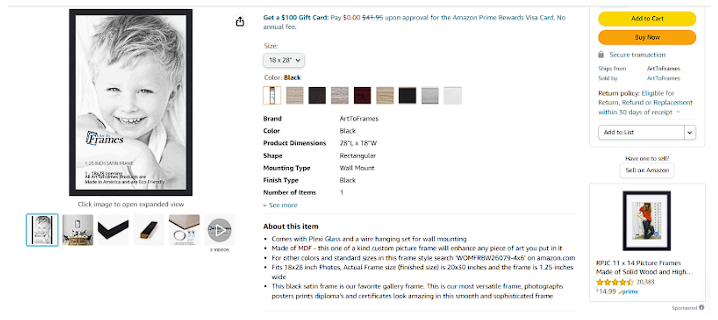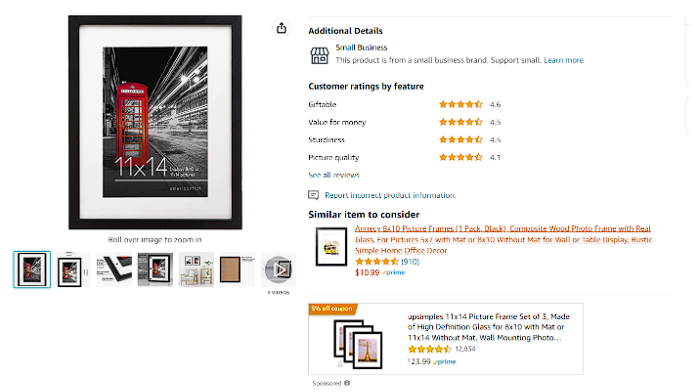
Amazon bidding is an essential skill to master for Amazon advertisers. It can be a helpful marketing strategy used in conjunction with Amazon SEO and off-Amazon marketing.
Amazon’s rule-based bidding can be a complex endeavor. This guide will help you understand the basics of bidding on Amazon so you can make informed decisions, get the most out of your advertising budget, and increase your sales on Amazon.
Ready to learn about how to out-bid your competitors on Amazon? Keep reading!
Table of Contents
What is Amazon Keyword Bidding & How Does It Work?
Keywords aren’t just for optimizing your Amazon listings. They are also critical to your ad strategy. When a customer searches for a product on Amazon, the site will display sponsored ads related to the keywords in the search.
Amazon’s advertisements belong to the advertiser with the highest bid and best ad relevance. Because of this, bidding the right amount on the right keywords is one of the most critical factors in securing success in Amazon advertising.
When advertisers create a sponsored ad campaign on Amazon, they set a budget and select the keywords they want to target. They will also set a maximum bid for each keyword, indicating the most they are willing to pay for a click on their ad. Many sellers use Amazon keyword tools to find the essential keywords for their products.
Amazon’s bidding system does not only take the financial aspect of a bid into account, however. The algorithm takes into account ad relevance, competition, and customer engagement. A lower bid may win if the advertisement is more relevant and will perform better.
Amazon Keyword Bidding Types
The Amazon rule-based bidding system automatically adjusts bids in real-time to show the best-fitting ad. Advertisements among the search results show the best bids. Keyword bidding determines where your ads will appear and how much you will pay each time a customer clicks on your ad. There are several different types of keyword bidding types. Let’sl go through them so you can optimize your advertising campaigns.
1. Dynamic Bids – Down Only

What it is: Advertisers set a target cost per click (CPC), and Amazon’s algorithm adjusts the bid for each keyword auction in real-time. The algorithm considers relevance, competition, and ad quality to determine the optimal bid for each auction. With the help of the algorithm, advertisers achieve the target CPC while maximizing ad visibility and conversion rates. The “Down Only” option means that Amazon can lower your bid if your advertisement is less likely to result in a click and purchase.
When to use it: This is a money-saving strategy that can keep you from buying ads for products with low conversion potential. It is beneficial with riskier bids because it helps keep your CPC amount aligned with your sales goals.
2. Dynamic Bids – Up and Down
What it is: This is similar to the last approach, but Amazon will adjust your bid either higher or lower depending on the likelihood of converting a click.
When to use it: This strategy can be a good option if you’re willing to spend more money than planned in competitive categories, as it may get you more clicks on your product listings.
3. Fixed Bids

What it is: Amazon will not adjust a fixed bid. It is a flat PPC rate.
When to use it: Some advertisers use fixed bids to take advantage of product launches in new niches while Amazon is still collecting data on them. However, it can be inefficient in most situations.
4. Bidding By Placement

appear (i.e., at the top of the search, embedded in search results, or on product pages).
When to use it: If you have reviewed the performance data for past advertising campaigns and found specific ad placements to be successful in your niche, you can set modifiers to increase based on placement.
5. Bidding By Type

What it is: You can use modifiers to adjust your keyword bid based on the type of match it makes. The four types are close match, loose match, substitutes, or complements.
When to use it: You can use this approach to adjust your PPC spending. Are you selling shampoo? You can increase your bid for your ad appearing on searches for complementary items like body wash and conditioner.
Amazon Campaign Bidding Strategy
Follow these steps to build a campaign bidding strategy for your Amazon ecommerce business.
1. Conduct Keyword Research
Before you get to Amazon rule-based bidding, one of the most important steps is to target keywords that are relevant to your products and have a high search volume. Save time and money by marketing your product to the right keywords.
There are several tools to find the best keywords for your campaign. An Amazon keyword optimization tool is a great way to find words with the highest profitability. With the right keywords, you can secure coveted top-of-page placements.
2. Understand Costs, Commission, ACoS, and RoAS
When it comes to keyword bidding and Amazon advertising, costs refer to the amount of money an advertiser spends on campaigns to reach customers.
Amazon charges the advertiser a commission fee when a customer purchases through one of Amazon’s PPC advertisements.
ACoS (Advertising Cost of Sales) is a metric that measures the proportion of advertising spending versus sales revenue generated by the advertising campaign. It is a percentage calculated by dividing the advertising cost by the sales revenue.
RoAS (Return on Ad Spend) is another metric that measures the return on investment from advertising spending. However, you can calculate this by dividing the revenue generated from the advertising campaign by the advertising cost.
Advertisers use both of these percentages to evaluate the performance and efficiency of their campaigns and help optimize future ad spending for better results.
3. Choose Your Amazon Ad Type
Amazon offers three Pay Per Click (PPC) ads for sellers to choose from:
- Sponsored Products: Embedded in search results, these ads target shoppers as they scroll through search results. Bidding on sponsored product ads is a good option for those who want to drive sales for specific products.
- Sponsored Brands: A sponsored brand ad is a banner that highlights a particular brand at the top, bottom, or to the side of search results. They display multiple products, so as an advertiser, you will bid on keywords, and Amazon’s algorithm determines which products display based on relevance and performance.
- Sponsored Display Ads: These appear on product pages below the “Add-to-Cart” button. Advertisers looking to make sales from shoppers tangentially looking for complementary products (like accessories to go with a top product) or substitute matches should consider bidding on these ads.
4. Choose Automatic or Manual Targeting
Automatic targeting allows Amazon’s algorithm to automatically determine the best ad keywords and placements based on product information and advertising goals. Automatic targeting is a good option for sellers new to Amazon advertising and looking to learn more about advertising without spending extensive time and money on keyword research.
Manual targeting allows advertisers to select keywords and ad placements based on research and advertising goals. This bidding allows for more customization and control over your campaigns but requires more time and effort to set up and manage.
5. Choose Your Amazon Bidding Type
It can be challenging to select a keyword bidding type, but we suggest starting with dynamic bids (down only). This strategy is less likely to result in you spending extra money and is an excellent way to experiment with the marketplace.
6. Calculate the Optimal Bid
When calculating the optimal bid, start with a smaller budget and gradually increase it as you see results. Gradually increasing your budget will help you avoid overspending and allow you to make adjustments to your campaign as needed.
Some advertisers take a much more mathematical approach with a widely-used equation to determine their bid:
Bid = Max. CPC = (Ad Sales / Ad Clicks) x (Ad Spend / Ad Sales)
7. Know When To Modify Your Amazon PPC Bids
Data collection is critical! Amazon offers reporting tools to track the performance of advertising campaigns, including clicks, impressions, granularity, and conversions. Use this information to change your campaign strategy and improve your results. Want to get more technical? There are also many agencies specializing in Amazon advertising optimization.
Amazon Keyword Bidding FAQs
What is a second-price auction?
A second-price auction is a type in which the winning bidder pays the second-highest rather than the highest bid. For Amazon advertisers, this determines the winning bid for sponsored products and sponsored brand ads. Advertisers bid on keywords and targeting criteria, and the highest bid wins the auction. However, instead of paying the total amount of their bid, the advertiser pays a slight premium over the second-highest bid.
This system ensures that advertisers only pay what they need to win the auction, rather than an exorbitant upper limit price while allowing Amazon to earn revenue from advertising on its platform. It also helps prevent excessively high bids, which could drive up the cost of advertising for both the advertiser and Amazon.
What are placement modifiers?
Placement modifiers are conditions or options within Amazon advertising that allow advertisers to control where their ads appear on the platform by modifying bids on specific placements. By altering bids on particular placements, advertisers have the most control over the cost of their campaigns and improve the return on their ad spend.
Should you use default bids in Amazon PPC?
Markets change daily, monthly, and seasonally, so using a default bid on Amazon (where you set a bid and do not adjust it) can mean you over or underspend. Maintaining flexibility by making regular adjustments to your bids and modifiers is critical to keep reaching your desired audience without wasting money.
Find the Best Keywords for Your Amazon Bidding Strategy
Mastering Amazon bidding can take time, but with the right knowledge and strategies, you can optimize your ad spend and get more clicks on your Amazon product listings.
While ad clicks are important, you also need an effective Amazon listing to improve conversion rates. Amazon tool Sellesta helps you improve your product listings with data-driven keyword suggestions for bullet points, titles, and descriptions.
With Sellesta, you get access to:
- Listing scoring: Get optimization checklists that provide insights on the main aspects of your listing: product title, product description, images, review count, etc.
- Keyword search integrated with listing optimization: Maximize organic traffic to your listing by finding the most important keywords to include.
- Listing optimization: Use our AI-driven listing optimization to improve your listing title, bullets, and generic keywords. The AI can generate these elements for you, making optimization quick and easy.
- Competitive analysis: Automatically identify your direct and indirect competitors and track their BSR, prices, ranking, and listing optimization score – all in real time.
- Review analysis: Our AI analyzes key tags and the emotional tone of key tags to break down what customers really think about your (and your competitors’) products. You can see where customers are having issues with your product and make the necessary changes. And, you gain insights on why customers love (or don’t love) a competitor’s product, and how to adjust yours accordingly.
With all of these features, who knows? You may even make the list of Amazon’s best-selling products.
Improve your Amazon sales with Sellesta.


